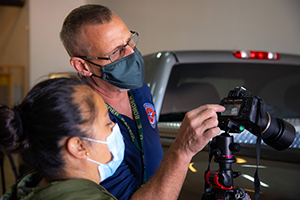
Texas Southmost College has a new workforce training course geared toward law enforcement agencies and professionals – Forensics Macro Photography, a course only available at TSC.
The course, led and taught by Thomas Kimbriel, a retired military, U.S. Border Patrol agent and FBI task force officer, focuses on using cutting-edge technology to identify human remains.
“Forensics Macro Technology is redefining how law enforcement agencies are identifying human remains and producing evidence useful in court,” said Kimbriel. “This is giving them the ability to collect fingerprints using photography and digital technology for quicker identification. This technique has a 98% identification rate.”
The course’s first cohort is made up of agents from the U.S. Border Patrol’s Missing Migrant unit, a group that uses this technique when attempting to reunify migrant families.
The Missing Migrant unit focuses on prevention of migrant deaths, locating migrants in distress, identifying migrant remains and reunifying migrants with their deceased loved ones.
Kimbriel introduced Forensics Macro Photography to the Border Patrol when he served on the intelligence unit and was tasked with creating an evidence collection team for the Rio Grande Valley several years ago.
Since then, the U.S. Border Patrol has been the only agency to use this technique, helping Texas counties and other law enforcement agencies like the Texas Rangers solve homicide cases and identify victim remains, and has enrolled agents in the course to train the new generation of agents on the force.
“This identifying technique has allowed us to make positive identifications and reunify families quicker, bringing closure to families and cases,” said Supervisory Border Patrol agent Brandon Coop. “We name unknown remains as John Doe’s or Jane Doe’s less.”
Coop said he was not involved with the Missing Migrant program when Kimbriel first introduced this method, so to be learning from him now and giving other agents the same opportunity is invaluable.
“Forensics Macro Photography is a game changer,” he said. “Our identification times have been cut dramatically, going from months and years down to only days.”
Nineteen-year Border Patrol veteran Gerardo Passement said he entered the Missing Migrant program upon Kimbriel’s retirement, so he trained under him for only a short time.
“This technique has really enhanced how I do my job. Tom brings a lot to light,” said Passement. “It’s been great for polishing up the skills I already know, learning new things and ensuring that our entire team is cross-trained with this skill. ”
Passement added that Forensics Macro Photography saves cities and counties thousands of dollars.
“It can cost anywhere from $350 a day or more to hold a body at a mortuary,” he said. “The cost is astronomical when it takes us close to a year to identify remains, but imagine the money we save with this macro photography technique that takes up to one week, at the longest.”
Those enrolled in TSC’s Forensic Macro Photography course will be trained in areas such as basic to advanced photography, photography lighting, post-mortem cleaning and photography techniques and post-mortem documentation processes.
“Having this ability is a huge tool for our agents, especially along the border,” said Kimbriel. “When you have an agency like the Border Patrol helping local and state law enforcement, it makes you aware that the demand for this skill is high and has potential to grow among other departments. We encourage other agencies to take advantage of this opportunity offered solely at TSC.”
For more information about TSC’s Forensics Macro Photography course, email the college’s Criminal Justice Institute at [email protected].
